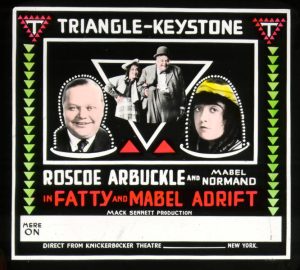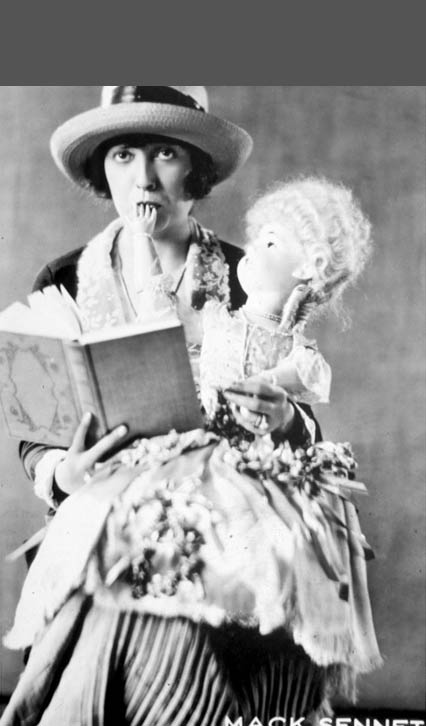by
Simon Joyce, Jennifer Putzi
Mabel Normand starred in at least one hundred and sixty-seven film shorts and twenty-three full-length features, mainly for Mack Sennett’s Keystone Film Company, and was one of the earliest silent actors to function as her own director. She was also one of the first leading performers to appear on film without a previous background in the theatre (having begun her career in modeling), to be named in the title of her films (beginning with 1912’s Mabel’s Lovers), and to have her own studio (the ill-fated Mabel Normand Feature Film Company). That her contributions to early film history are not better known is attributable in part to her involvement in the Hollywood scandals of the 1920s, and in part to our reliance on the self-interested memoirs of her better-known colleagues (especially Sennett and Charlie Chaplin) following her death at age thirty-eight. It is hard to get an accurate picture from such questionable and contradictory recollections, or from interviews with Normand herself, filtered as they often were through a sophisticated publicity operation at Keystone. Film scholars who have worked with these same sources have often proved just as discrepant and unreliable, especially in their accounts of her directorial contributions.
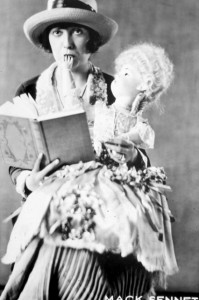
Mabel Normand with doll. Courtesy of the Library of Congress.
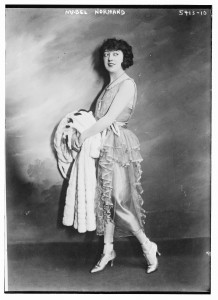
Mabel Normand portrait. Courtesy of the Library of Congress.
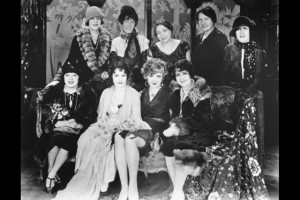
Leah Baird, Flora Finch, Ann Brody, Anne Shaeffer, Anita Stewart, Mabel Normand, Norma Talmadge, Constance Talmadge, Florence Turner, 1926. Courtesy of the Academy of Motion Picture Arts and Sciences, Margaret Herrick Library.
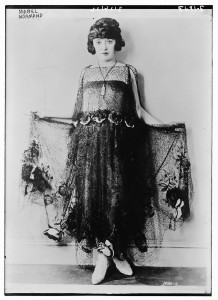
Mabel Normand portrait. Courtesy of the Library of Congress.
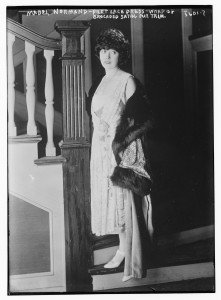
Mabel Normand portrait. Courtesy of the Library of Congress.
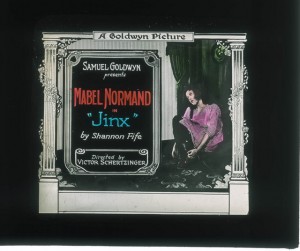
Lantern slide, Jinx (1919), starring Mabel Normand. Private Collection.
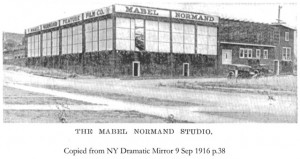
Photo of the Mabel Normand Studio. Private Collection.
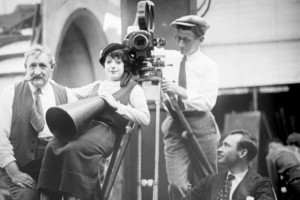
Mabel Normand sitting by camera. Courtesy of the Museum of Modern Art.
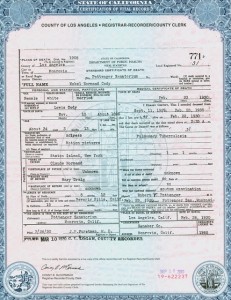
Mabel Normand’s death certificate.
Normand’s early career included stints at the Biograph Company, working with D. W. Griffith, and at the Vitagraph Company, yet it was her work at Keystone that solidified her image as slapstick comedienne. Typical roles featured her as the object of desire, often pursued by Sennett’s country “rube”; as an urban ingénue in films like the metacinematic Mabel’s Dramatic Career (1913), in which she becomes a Keystone actress; or as the helpless victim in parodies of period melodramas like Barney Oldfield’s Race for a Life (1913), in which she is the iconic woman tied to the railroad tracks. At other times, including the six-reel feature Tillie’s Punctured Romance (1914), she “gives as good as she gets,” as an accomplice and equal partner with Chaplin in the physical comedy of slapstick. Later, beginning with Mickey (1918), she sought to combine these different character tropes as a tomboy figure who actively works to overcome social adversity.
While Mabel Normand may have codirected at least two shorts with Sennett prior to 1914, including Tomboy Bessie at Biograph (1912), it was in this year that she identified her profession in the Los Angeles city directory as “director,” rather than “actress,” as she did in 1913 and 1915. Moving Picture World reported in December 1913 that the “leading woman of the Keystone Company, since its inception, is in the future to direct every picture she acts in. This will undoubtedly make Keystone more popular than ever, and this will give Miss Normand the opportunity of injecting some of her comedy, which she has never had an opportunity to put over before” (1289). It is hard, however, to definitively distinguish her films from others as they all evidence the studio’s recognizable house style, one that de-emphasized the responsibilities of the director (in those years uncredited on extant prints) and aimed for an apparently spontaneous—but actually carefully crafted—filmic effect. Questions of attribution remain open for most of the films listed below, with directorial credit often given to Sennett, Chaplin, or “Fatty” Arbuckle, her frequent costar following Chaplin’s departure, and they may never be answered, since the popularity of Keystone meant multiple re-edited prints and re-issues. In the absence of definitive information, our filmography has been generated by cross-referencing the listed published and online sources, noting where discrepancies occur.
As an example of the confusion, we might consider 1914’s Mabel at the Wheel, the second film she made with Chaplin, in which she resists the machinations of his character and drives a racing car to victory. Normand is listed as director in company records in the Keystone Collection housed in the Academy of Motion Picture Arts and Sciences, yet Moving Picture World reported in 1914 that “Mabel Normand and Mack Sennett collaborated in the direction of this picture” (680). Among more recent sources, Betty Harper Fussell and Kalton C. Lahue both credit the film to Normand alone, while three other sources list it as a collaboration (Fussell 257; Lahue 145). It was, moreover, in relation to the shooting of this film that Chaplin recalls complaining to Sennett about Normand’s “competence,” after which he claims he was allowed to direct all his films at Keystone (149). Sennett remembered events differently, however, suggesting that Chaplin’s apprenticeship lasted for “a dozen one- and two-reel pictures,” during which time he “learned [to direct] from Mabel Normand” (163–64). Finally, Normand herself later claimed in Picture Play that “For a long time, I directed all the pictures I played in, the best known of which are the Chaplin series” (46). Overall, she made eleven films at Keystone with Chaplin, and thirty-one in 1914 alone; if she did, indeed, direct all of the films in which she starred, this suggests a total directorial output far greater than that with which she is typically credited. Our research indicates that she acted as director or codirector for a total of twenty-six films made between 1912 and 1915; of these, however, our sources are in agreement on only seven titles.
Sennett’s motivation for encouraging Normand to direct is unclear. He clearly had respect for her talent as an actress, and most scholars agree that he had been in love with her. Although Mabel Normand was their first star, she was also notoriously underpaid at Keystone, and Sennett and his New York partners may have capitulated to her demands to direct in an effort to retain her. Chaplin’s salary famously rose to $1,250 per week after he left Keystone, for instance, while Normand was still paid $175 per week (Fussell 74). The abortive Mabel Normand Feature Film Company, launched in 1916 while the newly formed Triangle Film Corporation was collapsing, seems a belated effort by Sennett to placate the comedienne and to retain her services. Only one feature film, Mickey (1918), was released by the company, however, and only after Normand had already accepted a five-year contract with Samuel Goldwyn. The reason for the extended filming and post-production period for Mickey is, predictably, unclear, although Triangle’s management difficulties and Normand’s developing tuberculosis certainly played a role.
In 1920 Mabel Normand returned to Keystone to work with Sennett again on what was intended to be her come-back vehicle Molly O’ (1921). The release of the film was marred, however, by Fatty Arbuckle’s rape trials, and much of the rest of Normand’s career was similarly affected by scandal: the sensational—and unsolved—murder of close friend (and Motion Picture Directors Association president) William Desmond Taylor in 1922; a shooting two years later by Normand’s chauffeur; and persistent stories of her drug use and alcoholism. Even after her death, scholars have been more interested in the gossip surrounding Normand’s life and romances (including an announced marriage to Sennett in 1915 that never materialized) than her work. Among recent biographers, Fussell has speculated on a stillborn child with Goldwyn, while Simon Louvish’s study of Sennett suggests not only that Normand may have had hereditary syphilis, but also that Sennett may have been gay. Scholars would do well to refocus attention on Normand’s distinctive contribution to early cinema and slapstick comedy, as well as the nature of her directorial work for Keystone.
Bibliography
Chaplin, Charles. My Autobiography. New York: Simon and Schuster, 1964.
Fussell, Betty Harper. Mabel. New York: Limelight Editions, 1992.
Lahue, Kalton C. Kops and Custards: The Legend of Keystone Films. Norman: University of Oklahoma Press, 1968.
Los Angeles Directory Company. Los Angeles City Directory. Los Angeles: Los Angeles City Directory Company, 1913-1942.
Louvish, Simon. Keystone: The Life and Clowns of Mack Sennett. New York: Faber and Faber, 2003.
“Mabel at the Wheel.” Moving Picture World (2 May 1914): 680.
“Miss Normand, Director.” Moving Picture World (13 Dec. 1913): 1289.
Rex, Will. “Behind the Scenes with Fatty and Mabel.” Picture Play (April 1916): 46.
Archival Paper Collections:
Mabel Normand clippings file. Academy of Motion Picture Arts and Sciences, Margaret Herrick Library.
Mabel Normand collection compiled by William R. Meyer. Academy of Motion Picture Arts and Sciences, Margaret Herrick Library.
Mack Sennett papers. Academy of Motion Picture Arts and Sciences, Margaret Herrick Library.
Filmography
A. Archival Filmography: Extant Film Titles:
1. Mabel Normand as Actress, Director, Co-Director and/or Scenario Writer
The Engagement Ring. Dir.: Mack Sennett, au.: Mabel Normand (Biograph Co. US 1912) cas.: Mabel Normand, Edward Dillon, Dell Henderson, si, b&w. Archive: Library of Congress, Museum of Modern Art , Lobster Films.
Tragedy of a Dress Suit. Dir: Mack Sennett, sc: Mabel Normand (Biograph Co. US 1912) cas.: Mabel Normand, Eddie Dillon, Ford Sterling. si, b&w. Archive: Library of Congress, Museum of Modern Art, Cineteca del Friuli.
Tomboy Bessie. Dir.: Mack Sennett (Biograph Co. US 1912) cas.: Mabel Normand, Mack Sennett, si, b&w. Archive: Library of Congress, Museum of Modern Art, Cineteca del Friuli.
Won in a Cupboard/Won in a Closet. Dir.: Mabel Normand, prod.: Mack Sennett (Keystone Film Co. US 1914) cas.: Mabel Normand, si, b&w. Archive: Ngā Taonga Sound & Vision.
Caught in a Cabaret. Dir.: Mabel Normand (Keystone Film Co. US 1914) cas.: Mabel Normand, Charlie Chaplin, si, b&w. Archive: Library of Congress, Museum of Modern Art, BFI National Archive, George Eastman Museum, UCLA Film & Television Archive, Academy Film Archive, UC Berkeley Art Museum & Pacific Film Archive, Cinémathèque Québécoise, Cinemateca de Cuba, Fondazione Cineteca di Bologna, Cineteca del Friuli, Danske Filminstitut, Münchner Stadtmuseum.
The Fatal Mallet. Dir: Mack Sennett and Mabel Normand (Keystone Film Co. US 1914) cas.: Mabel Normand, Charlie Chaplin, Mack Sennett, si, b&w, 35mm. Archive: UCLA Film & Television Archive, Academy Film Archive, BFI National Archive, Cineteca del Friuli, EYE Filmmuseum.
Mabel at the Wheel. Dir: Mabel Normand, Mack Sennett (Keystone Film Co. US 1914) cas.: Mabel Normand, Charlie Chaplin, Mack Sennett, si, b&w, 35mm. Archive: Library of Congress, BFI National Archive, UCLA Film & Television Archive.
Mabel’s Blunder. Dir: Mabel Normand (Keystone Film Co. US 1914) cas.: Mabel Normand, si, b&w; 35mm. Archive: Library of Congress, Academy Film Archive.
Mabel’s Busy Day. Dir: Mabel Normand and Charlie Chaplin (Keystone Film Co. US 1914) cas.: Mabel Normand, Charlie Chaplin, si, b&w. Archive: Library of Congress, UCLA Film & Television Archive, BFI National Archive, Cinemateca de Cuba, Cineteca del Friuli, Danske Filminstitut, Filmoteca Española, Centre National du Cinéma et de l’Image Animée, Fundación Cinemateca Argentina.
Mabel’s Married Life. Dir: Charlie Chaplin and Mabel Normand (Keystone Film Co. US 1914) cas.: Charlie Chaplin, Mabel Normand, Mack Swain, si, b&w. Archive: Library of Congress, Museum of Modern Art, UCLA Film & Television Archive, Academy Film Archive, George Eastman Museum, BFI National Archive, Cinemateca Romana, Cinemateca de Cuba, Fondazione Cineteca di Bologna, Cineteca del Friuli, Danske Filminstitut, Hungarian National Film Archive, Cineteca Nazionale, Library and Archives Canada, Deutsche Kinemathek, Cinémathèque Québécoise, Lobster Films, Cinémathèque de Nice, Fundación Cinemateca Argentina.
Mabel’s Strange Predicament. Dir: Henry Lehrman, Mack Sennett (Keystone Film Co. US 1914) cas.: Charlie Chaplin, Mabel Normand, Chester Conklin, si, b&w, 35mm. Archive: Cineteca del Friuli, Danske Filminstitut, Filmoteca Española, Fundación Cinemateca Argentina, BFI National Archive, Lobster Films.
Mabel’s and Fatty’s Married Life. Dir: Mabel Normand, Edward Dillon (Keystone Film Co. US 1915) cas.: Mabel Normand, “Fatty” Arbuckle, si, b&w, 35mm. Archive: Library of Congress, Museum of Modern Art, UCLA Film & Television Archive, Cineteca del Friuli, Library and Archives Canada, Lobster Films.
Fatty and Mabel’s Simple Life (Keystone Film Co. US 1915) cas.: Mabel Normand, “Fatty” Arbuckle, si, b&w. Archive: Library of Congress, Museum of Modern Art, Cineteca del Friuli.
Mabel and Fatty’s Wash Day. Dir: Mabel Normand, Edward Dillon (Keystone Film Co. US 1915) cas.: Mabel Normand, “Fatty” Arbuckle, si, b&w, 35mm. Archive: Library of Congress, Cineteca del Friuli.
Mabel and Fatty Viewing the World’s Fair at San Francisco. Dir: “Fatty” Arbuckle, Mabel Normand (Keystone Film Co. US 1915) cas.: Mabel Normand, “Fatty” Arbuckle, si, b&w. Archive: Library of Congress, Museum of Modern Art, UCLA Film & Television Archive, Academy Film Archive, Cineteca del Friuli.
Mabel, Fatty and the Law/Fatty's Spooning Days.Dir: Edward Dillon, Mabel Normand (Keystone Film Co. US 1915) cas.: Mabel Normand, “Fatty” Arbuckle, Minta Durfree, si, b&w. Archive: Library of Congress, Museum of Modern Art, Academy Film Archive, Cineteca del Friuli.
Mabel Lost and Won. Dir: Mabel Normand (Keystone Film Co. US 1915) cas.: Mabel Normand, Mack Swain, si, b&w. Archive: Library of Congress, Centre National du Cinéma et de l’Image Animée.
Mabel’s Wilful Way. Dir: “Fatty” Arbuckle, Mabel Normand (Keystone Film Co. US 1915) cas.: Normand, Arbuckle si, b&w, 35mm. Archive: Library of Congress, UCLA Film & Television Archive, BFI National Archive, Cineteca del Friuli.
Wished on Mabel. Dir.: Mabel Normand (Keystone Film Co. US 1915) cas.: Mabel Normand, “Fatty” Arbuckle, si, b&w. Archive: Cineteca del Friuli, Lobster Films.
The Floor Below. Dir.: Clarence G. Badger (Goldwyn Pictures US 1918) cas.: Helen Dahl, Lincoln Plummer, Tom Moore, Wallace McCutcheon, Romaine Callender, Willard Dashiell, Mabel Normand, Charlotte Granville, si, b&w. Archive: EYE Filmmuseum.
2. Mabel Normand as Actress
A Tale of Two Cities. Dir.: William Humphrey (Vitagraph Company of America US 1911) cas.: Maurice Costello, Florence Turner, Tefft Johnson, Charles Kent, Mabel Normand, si, b&w, 35mm. Archive: Library of Congress, Museum of Modern Art, BFI National Archive, UCLA Film & Television Archive, Academy Film Archive.
The Baron. Dir.: D.W. Griffith (Biograph Co. US 1911) cas.: Dell Henderson, Grace Henderson, Mabel Normand, si, b&w. Archive: Museum of Modern Art, EYE Filmmuseum, Lobster Films.
Betty Becomes a Maid. (Vitagraph Company of America US 1911) cas.: Mabel Normand, Evangeline Blaisdell, Leo Delandy, si, b&w. Archive: BFI National Archive.
Dead Man’s Honor. (Vitagraph Company of America US 1911) cas.: Maurice Costello, Julia Swayne Gordon, Mabel Normand, si, b&w. Archive: BFI National Archive.
The Diamond Star. Dir.: D.W. Griffith (Biograph Co. US 1911) cas.: Wilfred Lucas, Florence Barker, Mabel Normand, si, b&w. Archive: Museum of Modern Art.
The Diving Girl. Dir.: Mack Sennett (Biograph Co. US 1911) cas.: Fred Mace, Mabel Normand, William J. Butler, si, b&w. Archive: Museum of Modern Art, UCLA Film & Television Archive.
Her Awakening. Dir.: D.W. Griffith (Biograph Co. US 1911) cas.: Harry Hyde, Mabel Normand, Kate Bruce, si, b&w. Archive: Museum of Modern Art, George Eastman Museum, UCLA Film & Television Archive.
The Inventor’s Secret. Dir.: Mack Sennett (Biograph Co. US 1911) cas.: Ford Sterling, Mabel Normand, si, b&w. Archive: Museum of Modern Art.
Italian Blood. Dir.: D.W. Griffith (Biograph Co. US 1911) cas.: Joseph Graybill, Wilfred Lucas, Vivian Prescott, Mabel Normand, si, b&w. Archive: Museum of Modern Art.
Making of a Man. Dir.: D.W. Griffith (Biograph Co. US 1911) cas.: Dell Henderson, Blanche Sweet, Guy Hedlund, Mabel Normand, si, b&w, 35mm. Archive:Museum of Modern Art, Library of Congress, Academy Film Archive.
The Revenue Man and the Girl. Dir.: D.W. Griffith (Biograph Co. US 1911) cas.: Edwin August, Dorothy West, Mabel Normand, si, b&w. Archive: Museum of Modern Art, George Eastman Museum, Academy Film Archive.
Saved From Himself. Dir.: D.W. Griffith (Biograph Co. US 1911) cas.: Joseph Graybill, Mabel Normand, si, b&w. Archive: Museum of Modern Art, EYE Filmmuseum, Lobster Films.
The Squaw’s Love. Dir.: D.W. Griffith (Biograph Co. US 1911) cas.: Dark Cloud, Mabel Normand, si, b&w. Archive: George Eastman Museum, Museum of Modern Art, Library and Archives Canada, BFI National Archive, Academy Film Archive.
Through His Wife’s Picture. Dir.: Mack Sennett (Biograph Co. US 1911) cas.: Fred Mace, Edward Dillon, Mabel Normand, si, b&w. Archive: Museum of Modern Art.
Troublesome Secretaries. Dir.: Ralph Ince (Vitagraph Company of America US 1911) cas.: Mabel Normand, John Bunny, Ralph Ince, si, b&w, 35mm. Archive: Library of Congress, Academy Film Archive.
The Unveiling. Dir.: Mack Sennett (Biograph Co. US 1911) cas.: Robert Harron, Grace Henderson, Mabel Normand, si, b&w. Archive: Museum of Modern Art.
A Victim of Circumstance. Dir.: Mack Sennett (Biograph Co. US 1911) cas.: Fred Mace, Dell Henderson, Lily Cahill, Mabel Normand, si, b&w. Archive: Museum of Modern Art.
Why He Gave Up. Dir.: Mack Sennett (Biograph Co. US 1911) cas.: Fred Mace, Mabel Normand, si, b&w. Archive: Museum of Modern Art.
The Brave Hunter. Dir.: Mack Sennett (Biograph Co. US 1912) cas.: Mabel Normand, Mack Sennett, Dell Henderson, si, b&w. Archive: Library of Congress, Museum of Modern Art, BFI National Archive, Lobster Films.
Cohen Collects a Debt. Dir.: Mack Sennett (Keystone Film Co. US 1912) cas.: Mabel Normand, Fred Mace, Ford Sterling, si, b&w, 35mm. Archive: Library of Congress.
At Coney Island. Dir.: Mack Sennett (Keystone Film Co. US 1912) cas.: Mabel Normand, Mack Sennett, si, b&w. Archive: EYE Filmmuseum.
Dash Through the Clouds. Dir.: Mack Sennett (Biograph Co. US 1912) cas.: Mabel Normand, Fred Mace, si, b&w. Archive: Cineteca del Friuli, George Eastman Museum, Library of Congress, Museum of Modern Art, UCLA Film & Television Archive, Academy Film Archive, Lobster Films.
The Deacon Outwitted, 1912. Dir.: Henry Lehrman (Keystone Film Co. US 1912) cas.: Ford Sterling, Al St. John, Betty Schade, Mabel Normand, si, b&w. Archive: Library and Archives Canada.
Eternal Mother. Dir.: D.W. Griffith (Biograph Co. US 1912) cas.: Edwin August, Blache Sweet, Mabel Normand, si, b&w. Archive: Museum of Modern Art, Library of Congress, George Eastman Museum.
The Fatal Chocolate. Dir.: Mack Sennett (Biograph Co. US 1912) cas.: Mabel Normand, Mack Sennett, Charles West, Dell Henderson, si, b&w, 35mm. Archive: Museum of Modern Art, BFI National Archive.
The Fickle Spaniard. Dir.: Mack Sennett (Biograph Co. US 1912) cas.: Mabel Normand, Fred Mace, Claire McDowell, si, b&w. Archive: Library of Congress, Museum of Modern Art, Cineteca del Friuli, Academy Film Archive, Lobster Films.
The Furs. Dir.: Mack Sennett (Biograph Co. US 1912) cas.: Mabel Normand, Dell Henderson, Mack Sennett, si, b&w. Archive: Library of Congress, Museum of Modern Art, Cineteca del Friuli, Lobster Films.
The Grocery Clerk’s Romance. Dir.: Mack Sennett (Keystone Film Co. US 1912) cas.: Mabel Normand, Ford Sterling, Harry McCoy, si, b&w. Archive: Lobster Films.
He Must Have a Wife. Dir.: Dell Henderson (Biograph Co. US 1912) cas.: Gus Pixley, Mabel Normand, William J. Butler, Ford Sterling, si, b&w. Archive: Museum of Modern Art, BFI National Archive.
Helen’s Marriage. Dir.: Mack Sennett (Biograph Co. US 1912) cas.: Mabel Normand, Edward Dillon, Grace Henderson, si, b&w. Archive: Museum of Modern Art, Library of Congress, Cineteca del Friuli, Lobster Films.
Help! Help! Dir.: Mack Sennett (Biograph Co. US 1912) cas.: Mabel Normand, Fred Mace, Dell Henderson, si, b&w, 35mm. Archive: Library of Congress, Museum of Modern Art, UCLA Film & Television Archive, Lobster Films.
Hot Stuff. Dir.: Mack Sennett (Biograph Co. US 1912) cas.: Mack Sennett, Mabel Normand, Dell Henderson, si, b&w. Archive: Library of Congress, Museum of Modern Art, Lobster Films.
Interrupted Elopement. Dir.: Mack Sennett (Biograph Co. US 1912) cas.: Mabel Normand, Ford Sterling, si, b&w. Archive: Museum of Modern Art, Library of Congress, Cineteca del Friuli.
Katchem Kate. Dir.: Mack Sennett (Biograph Co. US 1912) cas.: Mabel Normand, Fred Mace, si, b&w. Archive: Museum of Modern Art, Library of Congress, Cineteca del Friuli, Lobster Films.
Mabel’s Stratagem. Dir.: George Nicholls (Keystone Film Co. US 1912) cas.: Mable Normand, Fred Mace, si, b&w. Archive: Cineteca del Friuli.
The Mender of Nets. Dir.: D.W. Griffith (Biograph Co. US 1912) cas.: Mary Pickford, Charles West, Mabel Normand, si, b&w. Archive: George Eastman Museum, Museum of Modern Art, Library and Archives Canada, BFI National Archive, UCLA Film & Television Archive, National Film and Sound Archive of Australia, Library of Congress.
Mr. Grouch at the Seashore. Dir.: Dell Henderson (Biograph Co. US 1912) cas.: Edward Dillon, J. Jiquel Lanoe, Jack Pickford, Mabel Normand, si, b&w. Archive: Museum of Modern Art.
Neighbors. Dir.: Mack Sennett (Biograph Co. US 1912) cas.: Fred Mace, Mabel Normand, Sylvia Ashton, si, b&w, 35mm. Archive: Museum of Modern Art, Library of Congress, Cineteca del Friuli, UCLA Film & Television Archive, Academy Film Archive.
The New Baby. Dir.: Mack Sennett (Biograph Co. US 1912) cas.: Mabel Normand, Mack Sennett, si, b&w. Archive: Museum of Modern Art.
Oh, Those Eyes! Dir.: Mack Sennett (Biograph Co. US 1912) cas.: Mabel Normand, Dell Henderson, Edward Dillon, si, b&w, 35mm. Archive: Library of Congress, Museum of Modern Art, BFI National Archive, Ngā Taonga Sound & Vision, Lobster Films.
The Rivals. Dir.: Mack Sennett (Keystone Film Co. US 1912) cas.: Mabel Normand, Ford Sterling, Mack Sennett, si, b&w, 35mm. Archive: George Eastman Museum, Library of Congress, UCLA Film & Television Archive, Lobster Films.
The Spanish Dilemma. Dir.: Mack Sennett (Biograph Co. US 1912) cas.: Mabel Normand, Mack Sennett, Fred Mace, si, b&w, 35mm. Archive: Museum of Modern Art, BFI National Archive, UCLA Film & Television Archive, Academy Film Archive, Lobster Films.
The Tourists. Dir.: Mack Sennett (Biograph Co. US 1912) cas.: Mabel Normand, Charles West, William J. Butler, Grace Henderson, si, b&w, 35mm. Archive: Library of Congress, Museum of Modern Art, UCLA Film & Television Archive, Lobster Films.
A Voice from the Deep. Dir.: Mack Sennett (Biograph Co. US 1912) cas.: Mabel Normand, Charles West, William J. Butler, Grace Henderson, si, b&w, 35mm. Archive: Library of Congress, Museum of Modern Art, UCLA Film & Television Archive, Lobster Films.
The Water Nymph. Dir.: Mack Sennett (Keystone Film Co. US 1912) cas.: Mabel Normand, Ford Sterling, Mack Sennett, Mary Maxwell, si, b&w, 35mm. Archive: Cineteca del Friuli, UCLA Film & Television Archive, Academy Film Archive, Svenska Filminstitutet , Lobster Films.
What the Doctor Ordered. Dir.: Mack Sennett (Biograph Co. US 1912) cas.: Mabel Normand, Mack Sennett, Kate Toncray, Edward Dillon, si, b&w. Archive: Museum of Modern Art, Library of Congress, Cineteca del Friuli, Lobster Films.
When Kings Were the Law. Dir.: D.W. Griffith (Biograph Co. US 1912) cas.: Wilfred Lucas, Harry Hyde, Dorothy Bernard, J. Jiquel Lanoe, Mabel Normand, si, b&w. Archive: Museum of Modern Art, Library of Congress, BFI National Archive.
The Bangville Police. Dir.: Henry Lehrman (Keystone Film Co. US 1913) cas.: Mabel Normand, Nick Cogley, Dot Farley, Fred Mace, si, b&w, 35mm. Archive: Cineteca del Friuli, Library of Congress, Museum of Modern Art, UCLA Film & Television Archive, UC Berkeley Art Museum & Pacific Film Archive, Lobster Films.
Barney Oldfield’s Race for a Life. Dir.: Mack Sennett (Keystone Film Co. US 1913) cas.: Mabel Normand, Mack Sennett, Ford Sterling, Helen Holmes, si, b&w. Archive: Cinema Museum, Cineteca del Friuli, George Eastman Museum, Library of Congress, Museum of Modern Art, Library and Archives Canada, UCLA Film & Television Archive, Academy Film Archive, UC Berkeley Art Museum & Pacific Film Archive, National Film and Sound Archive of Australia.
The Bowling Match. Dir.: Mack Sennett (Keystone Film Co. US 1913) cas.: Mabel Normand, Ford Sterling, Fred Mace, si, b&w, 35mm. Archive: Museum of Modern Art, Cinemateca Romana.
The Cure That Failed. Dir.: George Nicholls (Keystone Film Co. US 1913) cas.: Mabel Normand, Ford Sterling, si, b&w. Archive: BFI National Archive.
The Gusher. Dir.: Mack Sennett (Keystone Film Co. US 1913) cas.: Mabel Normand, Ford Sterling, si, b&w, 35mm. Archive: Münchner Stadtmuseum [DEI], George Eastman Museum.
A Healthy Neighborhood. Dir.: Mack Sennett (Keystone Film Co. US 1913) cas.: Mabel Normand, Ford Sterling, si, b&w. Archive: BFI National Archive, Cineteca Nazionale.
Her Dramatic Debut. Dir.: Mack Sennett (Keystone Film Co. US 1913) cas.: Mabel Normand, Mack Sennett, Virginia Kirtley, si, b&w. Archive: Academy Film Archive.
Hide and Seek. Dir.: George Nichols (Keystone Film Co. US 1913) cas.: Ford Sterling, Betty Schade, Nick Cogley, Mabel Normand, Helen Holmes, si, b&w, 35mm. Archive: Library of Congress, Lobster Films.
A Little Hero. Dir.: George Nichols (Keystone Film Co. US 1913) cas.: Mabel Normand, George Nichols, si, b&w. Archive: BFI National Archive, EYE Filmmuseum.
Mabel’s Awful Mistakes. Dir.: Mack Sennett (Keystone Film Co. US 1913) cas.: Mabel Normand, Mack Sennett, si, b&w, 35mm. Archive: George Eastman Museum.
Mabel’s New Hero. Dir.: Mack Sennett (Keystone Film Co. US 1913) cas.: Mabel Normand, “Fatty” Arbuckle, Charles Avery, si, b&w. Archive: Museum of Modern Art, UC Berkeley Art Museum & Pacific Film Archive, Cinémathèque Québécoise, Lobster Films.
A Muddy Romance. Dir.: Mack Sennett, George Nichols (Keystone Film Co. US 1913) cas.: Mabel Normand, Ford Sterling, Minta Durfee, si, b&w, 35mm. Archive: Library of Congress, Library and Archives Canada, BFI National Archive, UCLA Film & Television Archive, Academy Film Archive, Lobster Films.
A Noise from the Deep. Dir.: Mack Sennett (Keystone Film Co. US 1913) cas.: Mabel Normand, “Fatty” Arbuckle, Mack Sennett, si, b&w. Archive: Jugoslovenska Kinoteka, Museum of Modern Art.
The Riot. Dir.: Mack Sennett (Keystone Film Co. US 1913) cas.: Fort Sterling, Charles Murray, Mabel Normand, si, b&w. Archive: BFI National Archive, Filmoteca de Catalunya.
The Speed Kings. Dir.: Mack Sennett (Keystone Film Co. US 1913) cas.: Mabel Normand, “Fatty” Arbuckle, Teddy Tetzlaff, Earl Cooper, si, b&w. Archive: Cineteca del Friuli, Academy Film Archive, Lobster Films, Library of Congress.
A Strong Revenge. Dir.: Mack Sennett (Keystone Film Co. US 1913) cas.: Mabel Normand, Ford Sterling, Mack Sennett, si, b&w. Archive: Lobster Films.
That Ragtime Band. Dir.: Mack Sennett (Keystone Film Co. US 1913) cas.: Mabel Normand, Ford Sterling, Nick Cogley, si, b&w, 35mm. Archive: Library of Congress.
Those Good Old Days. Dir.: Mack Sennett (Keystone Film Co. US 1913) cas.: Mabel Normand, Ford Sterling, Phyllis Allen, si, b&w. Archive: Lobster Films.
When Dreams Come True. Dir.: Mack Sennett (Keystone Film Co. US 1913) cas.: Mabel Normand, “Fatty” Arbuckle, Ford Sterling, Fred Mace, si, b&w. Archive: George Eastman Museum.
Cohen Saves the Flag. Dir.: Mack Sennett (Keystone Film Co. US 1913) cas.: Mabel Normand, Ford Sterling, Henry Lehrman, si, b&w, 16mm, DVD, Beta. Archive: Academy Film Archive, National Center for Jewish Film.
A Film Johnnie. Dir.: George Nichols (Keystone Film Co. US 1914) cas.: Charlie Chaplin, Mabel Normand, Virginia Kirtley, “Fatty” Arbuckle, si, b&w, 35mm. Archive: Cinemateca Romana, Cineteca del Friuli, Danske Filminstitut, Library of Congress, Hungarian National Film Archive, UCLA Film & Television Archive, Cinémathèque de Nice, National Film and Sound Archive of Australia, Lobster Films.
Fatty’s Wine Party. Dir.: “Fatty” Arbuckle, Eddie Dillon (Keystone Film Co. US 1914) cas.: “Fatty” Arbuckle, Minta Durfee, Mabel Normand, Mack Swain, si, b&w, 35mm. Archive: Library of Congress, BFI National Archive.
Gentlemen of Nerve. Dir.: Charles Chaplin (Keystone Film Co. US 1914) cas.: Charlie Chaplin, Mabel Normand, Mack Swain, si, b&w, 35mm. Archive: Centre National du Cinéma et de l’Image Animée, Fundación Cinemateca Argentina, Library of Congress, BFI National Archive, Cineteca del Friuli, George Eastman Museum, UCLA Film & Television Archive, Cinémathèque Québécoise, Danske Filminstitut, Lobster Films.
His Trysting Place. Dir.: Charles Chaplin (Keystone Film Co. US 1914) cas.: Charlie Chaplin, Mabel Normand, Mack Swain, si, b&w, 35mm. Archive: Centre National du Cinéma et de l’Image Animée [FRB], Cinémathèque Québécoise, Cinemateca do Museu de Arte Moderna, Fondazione Cineteca di Bologna, Cineteca del Friuli, Israel Film Archive/Jerusalem Cinematheque, Library of Congress, Museum of Modern Art, Library and Archives Canada, BFI National Archive, UCLA Film & Television Archive, George Eastman Museum, Academy Film Archive, Danske Filminstitut, Lobster Films.
An Incompetent Hero. Dir.: “Fatty” Arbuckle, Eddie Dillon (Keystone Film Co. US 1914) cas.: “Fatty” Arbuckle, Minta Durfee, Mabel Normand, si, b&w, 35mm. Archive: Library of Congress, UCLA Film & Television Archive.
Mabel’s Blunder. (Keystone Film Co. US 1914) cas.: Mabel Normand, Charley Chase, si, b&w, 35mm. Archive: Library of Congress, Academy Film Archive.
The Sea Nymphs. Dir.: “Fatty” Arbuckle (Keystone Film Co. US 1914) cas.: “Fatty” Arbuckle, Minta Durfee, Mabel Normand, si, b&w. Archive: Danske Filminstitut, Münchner Stadtmuseum, George Eastman Museum.
Those Country Kids. Dir.: “Fatty” Arbuckle, Eddie Dillon (Keystone Film Co. US 1914) cas.: “Fatty” Arbuckle, Mabel Normand, Al St. John, si, b&w, 35mm. Archive: Library of Congress, BFI National Archive.
Tillie’s Punctured Romance. Dir.: Mack Sennett (Keystone Film Co. US 1914) cas.: Charles Chaplin, Mabel Normand, Marie Dressler, si, b&w, 35mm. Archive: Bulgarska Nacionalna Filmoteka, Academy Film Archive, Cinémathèque Royale de Belgique, Cineteca del Friuli, Filmoteka Narodowa, Gosfilmofond, Library of Congress, Hungarian National Film Archive, Museum of Modern Art, BFI National Archive, EYE Filmmuseum, Cinemateca Romana, Cinémathèque Québécoise, Filmoteca de Catalunya, Harvard Film Archive, National Film and Sound Archive of Australia, Lobster Films, UCLA Film & Television Archive, Danske Filminstitut.
Fatty and Mabel at the San Diego Exposition. Dir.: “Fatty” Arbuckle (Keystone Film Co. US 1915) cas.: Mabel Normand, “Fatty” Arbuckle, si, b&w. Archive: Cineteca del Friuli, Lobster Films.
Getting Acquainted. Dir.: Charles Chaplin (Keystone Film Co. US 1915) cas.: Charlie Chaplin, Mabel Normand, Mack Swain, si, b&w. Archive: Cineteca del Friuli, Danske Filminstitut, Library of Congress, Museum of Modern Art, BFI National Archive, Cineteca Nazionale, UCLA Film & Television Archive, Academy Film Archive, Filmoteca de Catalunya, Cinémathèque Québécoise, Fondazione Cineteca di Bologna, Lobster Films.
The Little Teacher. Dir.: Mack Sennett (Keystone Film Co. US 1915) cas.: Mabel Normand, Mack Sennett, Fatty Arbuckle, si, b&w. Archive: Library of Congress.
My Valet. Dir.: Mack Sennett (Keystone Film Co. US 1915) cas.: Mabel Normand, Mack Sennett, Raymond Hitchcock, si, b&w. Archive: Danske Filminstitut, UCLA Film & Television Archive, Library of Congress.
That Little Band of Gold. Dir.: “Fatty” Arbuckle (Keystone Film Co. US 1915) cas.: Mabel Normand, “Fatty” Arbuckle, Ford Sterling, si, b&w, 35mm. Archive: Cineteca del Friuli, Lobster Films, Library of Congress.
Their Social Splash. Dir.: Arvid E. Gillstrom, Charles Avery (Keystone Film Co. US 1915) cas.: Charles Murray, Polly Moran, Slim Summerville, Mabel Normand, si, b&w. Archive: Cineteca del Friuli, BFI National Archive, Lobster Films.
Fatty and Mabel Adrift. Dir.: “Fatty” Arbuckle (Keystone Film Co. US 1916) cas.: Mabel Normand, “Fatty” Arbuckle, Al St. John, si, b&w. Archive: Cineteca del Friuli, Museum of Modern Art, George Eastman Museum, Library of Congress, Academy Film Archive, UCLA Film & Television Archive, UC Berkeley Art Museum & Pacific Film Archive, Lobster Films, Danske Filminstitut.
He Did and He Didn’t. Dir.: “Fatty” Arbuckle (Keystone Film Co. US 1916) cas.: Mabel Normand, “Fatty” Arbuckle, Al St. John, si, b&w. Archive: George Eastman Museum, Library of Congress, EYE Filmmuseum, Cineteca del Friuli, UCLA Film & Television Archive, Lobster Films.
What Happened to Rosa. Dir.: Victor Schertzinger (Goldwyn Pictures Corp. US 1920) cas.: Mabel Normand, Hugh Thompson, Tully Marshall, si, b&w, 35mm. Archive: Cineteca del Friuli, Library of Congress, Lobster Films.
When Doctors Disagree. Dir.: Victor Schertzinger (Goldwyn Pictures Corp. US 1920) cas.: Mabel Normand, Walter Hiers, George Nichols, si, b&w. Archive: Cinémathèque Royale de Belgique.
Head Over Heels. Dir.: Victor Schertzinger, Paul Bern (Goldwyn Pictures Corp. US 1922) cas.: Mabel Normand, Hugh Thompson, Adolphe Menjou, si, b&w. Archive: Library of Congress.
Oh, Mabel Behave. Dir.: Mack Sennett, For Sterling (Triangle Film Corp. US 1922) cas.: Mack Sennett, Mabel Normand, Ford Sterling, si, b&w. Archive: Cinémathèque Française.
Suzanna. Dir.: F. Richard Jones (Mack Sennett Comedies. US 1922) cas.: Mabel Normand, George Nichols, Walter McGrail, si, b&w. Archive: Gosfilmofond.
The Extra Girl. Dir.: F. Richard Jones (Mack Sennett Comedies.. US 1923) cas.: Mabel Normand, Ralph Graves, George Nichols, si, b&w. Archive: Cineteca del Friuli, George Eastman Museum, Museum of Modern Art, Gosfilmofond, UCLA Film & Television Archive, Cinémathèque Québécoise, Lobster Films.
The Nickel-Hopper. Dir.: F. Richard Jones (Hal Roach Studios, Inc. US 1926) cas. : Mabel Normand, Theodore von Eltz, si, b&w. Archive : UCLA Film & Television Archive, George Eastman Museum, Lobster Films.
Raggedy Rose. Dir. : Richard Wallace (Hal Roach Studios, Inc. US 1926) cas. : Mabel Normand, Carl Miller, Max Davidson, si, b&w. Archive : UCLA Film & Television Archive, BFI National Archive, Lobster Films.
Anything Once! Dir.: Hal Yates, F. Richard Jones (Hal Roach Studios, Inc. US 1927) cas.: Mabel Normand, James Finlayson, si, b&w. Archive : Lobster Films.
Should Men Walk Home? Dir.: Leo McCarey (Hal Roach, Inc. US 1927) cas.: Mabel Normand, Creighton Hale, Oliver Hardy, si, b&w. Archive: UCLA Film & Television Archive, BFI National Archive.
3. Mabel Normand as Actress and Producer (Mabel Normand Feature Film Co.)
Mickey. Prod.: Mack Sennett, Mabel Normand, dir.: F. Richard Jones, James Young (Mabel Normand Feature Film Co. US 1918) cas.: Mabel Normand, George Nichols, Wheeler Oakman, si, b&w. Archive: Cinémathèque Royale de Belgique, Library of Congress, Museum of Modern Art, BFI National Archive, Cinemateca Romana, Cineteca del Friuli, UCLA Film & Television Archive, Filmoteca UNAM.
Molly O’. Prod.: Mack Sennett, Mabel Normand, dir.: F. Richard Jones (Mabel Normand Feature Film Co. US 1921) cas.: Mabel Normand, George Nichols, si, b&w. Archive: Gosfilmofond, UCLA Film & Television Archive.
B. Filmography: Non-Extant Film Titles:
1. Mabel Normand as Actress and Director or Co-Director
Foiling Fickle Father, 1913; Hello Mabel, 1914; Her Friend the Bandit, 1914; Love and Gasoline, 1914; Mabel’s Bear Escape, 1914; Mabel’s Latest Prank, 1914; Mabel’s Nerve, 1914; Mabel’s New Job, 1914; Mabel’s Stormy Love Affair, 1914; A Thief Catcher, 1914.
2. Mable Normand as Actress
Indiscretions of Betty, 1910; Over the Garden Wall, 1910, Willful Peggy, 1910; The Changing of Silas Warner, 1911; His Mother, 1911; Picciola , 1911; How Betty Won the School, 1911; Saved From Herself, 1911; The Strategy of Ann, 1911; The Subduing of Mrs. Nag, 1911; Two Overcoats, 1911; When a Man’s Married His Trouble Begins, 1911; Ambitious Butler, 1912; At It Again, 1912; The Beating He Needed,1912; Brown’s Séance, 1912; The Deacon’s Troubles, 1912; A Desperate Lover, 1912; The Drummer’s Vacation, 1912; The Duel, 1912; A Family Mixup, 1912; The Flirting Husband, 1912; Kings Court, 1212; Mabel’s Adventures, 1912; Mabel’s Lovers,1912; A Midnight Elopement, 1912; Mr. Fix-It, 1912; The New Neighbor, 1912; Pat’s Day Off, 1912; Pedro’s Dilemma, 1912; A Race for a Life, 1212; Tempermental Husband, 1912; Baby Day, 1913; The Battle of Who Run, 1913; Brothers, 1913; The Doctored Affair, 1913; A Double Wedding, 1913; Faithful Taxicab, 1913; Father’s Choice, 1913; Fatty at San Diego, 1913; Fatty’s Flirtation, 1913; For Lizzie’s Sake, 1913; For the Love of Mabel, 1913; The Foreman of the Jury, 1913; Gypsy Queen, 1913; The Hansom Driver, 1913; Heinze’s Resurrection, 1913; Her New Beau, 1913; Hubby’s Job, 1913; Just Brown’s Luck,1913; Love and Courage, 1913; Love and Pain, 1913; Love Sickness at Sea, 1913; Mabel’s Heroes, 1913; Mistaken Masher, 1913; On His Wedding Day, 1913; Passions, He Had Three, 1913; Professor Bean’s Removal, 1913; Professor’s Daughter, 1913; Red Hot Romance, 1913; The Rube and the Baron, 1913; The Rural Third Degree, 1913; Saving Mabel’s Dad, 1913; The Sleuths at the Floral Parade, 1913; The Speed Queen, 1913; A Tangled Affair, 1913; The Telltale Light, 1913; A Twelve O’Clock, 1913; Two Widows, 1913; The Waiters’ Picnic, 1913; Zuzu, the Band Leader, 1913; The Alarm, 1914; A Gambling Rube, 1914; Glimpse of Los Angeles, 1914; In the Clutches of the Gang, 1914; Lovers Post Office, 1914; Mack at It Again, 1914; A Misplaced Foot, 1914; A Missing Bride, 1914; Shotguns that Kick, 1914; The Sky Pirate, 1914; Where Hazel Met the Villain, 1914; Rum and Wall Paper, 1915; Stolen Magic, 1915; Back to the Woods, 1918; Dodging a Million, 1918; Joan of Plattsburg, 1918; Peck’s Bad Girl, 1918; A Perfect 36, 1918; The Venus Model, 1918; Jinx, 1919; The Pest, 1919; Sis Hopkins, 1919; Upstairs, 1919; Pinto, 1920; The Slim Princess, 1920; One Hour Married, 1927.
3. Mable Normand as Herself
Charlie’s Life, 1916; Stake Uncle Sam to Play Your Hand, 1918.
C. DVD Sources:
Early Women Filmmakers: An International Anthology. DVD. (Flicker Alley US 2017) - contains Mabel's Strange Predicament (1914)
Pioneers: First Women Filmmakers. DVD/Blu-ray. (Kino Lorber US 2018) - contains Caught in a Cabaret (1914), Mabel's Blunder (1914), Mabel Lost and Won (1915), andMabel and Fatty's Wash Day (1916), and other special features
Les Pionnières du Cinéma. DVD/Blu-ray. (Lobster Films France 2018) - contains Mabel's Strange Predicament (1914)
Early Women Filmmakers 1911-1940. DVD/Blu-ray. (BFI UK 2019) - contains Mabel's Strange Predicament (1914)
Lost and Found: American Treasures from the New Zealand Film Archive (1914-1929). DVD. (NFPF US 2013) - contains Won in a Cupboard (1914)
The Movies Begin. DVD. (Kino Video US 2002) - contains The Bangville Police (1913)
Slapstick Encyclopedia. DVD. (Image Entertainment US 2002)
Chaplin at Keystone. DVD. (Flicker Alley US 2010)- contains Mabel's Strange Predicament (1914), Mabel at the Wheel (1914), Caught in a Cabaret (1914). The Fatal Mallet (1914), Her Friend the Bandit (1914), Mabel's Busy Day (1914), Gentlemen of Nerve (1914), Getting Acquainted (1914), and Tillie's Punctured Romance (1914).
Charlie Chaplin Marathon (1914-1917). DVD. (Delta Entertainment US 2002)
Charlie Chaplin Collectors Classics (1914-1925). DVD. (Front Row Entertainment US 2002)
Keystone Comedies, Vol. 2. DVD. (Grapevine Video US 2007)
Tillie's Punctured Romance (with Tillie Wakes Up. DVD. (Grapevine US 2014)
Tillie's Punctured Romance (with Mabel's Married Life). DVD. (Image Entertainment US 1999)
The Extra Girl. DVD. (Kino International US 2008)
Mickey. DVD. (Grapevine Video US 2009)
The Actors: Rare Films of Mabel Normand, Volume 1. DVD. (Classic Video Streams US 2010) - contains Troublesome Secretaries (1911), Mickey (1918), and Raggedy Rose (1926)
The Actors: Rare Films of Mabel Normand, Volume 2. DVD. (Classic Video Streams US 2010) - contains The Water Nymph (1913), A Strong Revenge (1913), That Ragtime Band (1913), Mabel's New Hero (1913), A Muddy Romance (1913), Hide and Seek (1913), Speed Kings (1913), Mabel's Blunder (1914), Little Teacher/Small Town Bully (1915), The Nickel Hopper (1926), and Anything Once (1927)
The Actors: Rare Films of Mabel Normand, Volume 3. DVD. (Classic Video Streams US 2010) - contains Cohen Saves the Flag (1913), Mabel and Fatty Viewing the World's Fair at San Francisco, Cal. (1915), What Happened to Rosa (1920), and The Extra Girl (1923)
Sennett Classics (1911-1928). DVD. (Alpha Video US 2012)
The Mack Sennett Collection Vol. 1. DVD (Flicker Alley US 2014)
Fatty Arbuckle Festival (1913-1915). DVD. (Mill Creek Entertainment US 2005)
What Happened to Rosa (with Mabel's Blunder and The Little Teacher. DVD. (Grapevine Vide US 2008)
D. Streamed Media:
At Coney Island (1912) is streaming online via the EYE Filmmuseum (Dutch intertitles)
A Little Hero (1913) is streaming online via the EYE Filmmuseum (Dutch intertitles)
The Speed Kings (1913) is streaming on Amazon Video
The Speed Kings (1913) is streaming online via Kanopy
Fatty's Spooning Days (1915) is streaming on Amazon Prime
He Did and He Didn't (1916) is streaming online via the EYE Filmmuseum (Dutch intertitles)
The Floor Below (1918) is streaming online via the EYE Filmmuseum (Dutch intertitles)
The Extra Girl (1923) is streaming on Amazon Video
The Extra Girl (1923) is streaming online via Kanopy
The Best of Keystone Kops Vol. 1 is streaming on Amazon Prime
Credit Report
In compiling this filmography, we have referred to the following sources: Keystone Company release records for March 1913 to April 1914, in the Sennett collection at AMPAS; FIAF database; filmographies for Normand and Keystone appended to Fussell and Lahue; Kemp Niver’s catalog for the Library of Congress's Paper Print Collection (for Biograph releases); Brooks Bushnell, Directors and Their Films, 1895-1990 (Jefferson, NC: MacFarland & Co., 1993); and a web-based Normand filmography on Angelfire. A large number—but by no means all—of the discrepancies we note here stem from a desire on the part of Normand’s celebrated male co-stars Chaplin and Arbuckle (as well as their subsequent champions) to claim shared directorial credit as well as joint top billing. Additional sources used to track Normand’s acting career include the Braff Papers, Paul Spehr’s company credits, Denise Lowe’s Encyclopedic Dictionary and the AFI catalogue. Specific issues are listed below: Tomboy Bessie is listed as being co-directed by Normand in Fuseell, but all other sources list Sennett as the sole director. Fatty and Mabel’s Simple Life lists no director, but the film is usually credited to Arbuckle or Arbuckle/Normand. Those Country Kids. Is listed as the as being directed by Eddie Dillon in FIAF, but most other sources and filmographies list Arbuckle as the director. The Gusher is listed at 1913 in all sources including filmographies about Arbuckle and Sterling, however it is listed as 1912 in FIAF. The Speed Kings is sometimes credited as Teddy Tetzlaff and Earl Cooper. The director is also listed as Mack Sennett in some sources as as Wilfred Lucas in others. Her Dramatic Debut is listed in FIAF, but with no cast or crew information, however the film is credited in most sources as Mabel’s Dramatic Career, and credits were culled using the second title. The director of A Little Hero is usually credited to Mack Sennett, however the FIAF record lists George Nichols. Some sources list Mabel Normand as appearing as an extra in the D.W. Griffith short Near to Earth (1913), which seems unlikely as by 1913, Normand and Sennett had both left Biograph. The Deacon Outwitted lists the year of release as 1914 in Braff, 1912 in FIAF, and 1913 in Denise Lowe’s Encyclopedic Dictionary. The Fickle Spaniard is credited to Mack Sennett in all sources, however, FIAF also lists Dell Henderson and co-director. A Voice from the Deep is not listed in FIAF, Braff or Spehr, however, it is listed in Lowe and Fussell. The Baron is credited on FIAF as being directed by D.W. Griffith, however, it is credited to Mack Sennett is most other sources.
Citation
Joyce, Simon; Jennifer Putzi. "Mabel Normand." In Jane Gaines, Radha Vatsal, and Monica Dall’Asta, eds. Women Film Pioneers Project. New York, NY: Columbia University Libraries, 2013. <https://doi.org/10.7916/d8-e84a-he64>
